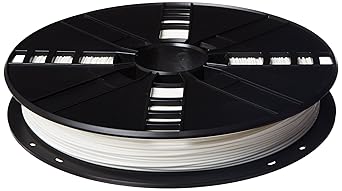Page Contents
Details: MakerBot PLA 3D Printing Filament Large Spool for Use with MakerBot’s Replicator+ & 5th Generation Line of 3D Printers, Non-Toxic Resin, 1.75mm Diameter, White (MP05780)
Brand: MakerBot
MakerBot PLA 3D Printing Filament (MP05780) is the best and most consistent material optimized for use with MakerBot’s Replicator+ and MakerBot’s 5th Generation Line of 3D Printers. This large size 1.75mm diameter spool is for use in the MakerBot Replicator+, MakerBot Replicator Desktop 3D Printer (5th Gen), MakerBot Replicator Z18 3D Printer, or MakerBot Replicator 2 Desktop 3D Printer. All MakerBot Material is manufactured to produce the highest quality 3D prints and is trusted by leading companies and institutions the world over, thanks to state-of-the-art material manufacturing and quality control standards. Comprehensively quality tested at both 100-micron and 200-micron layer resolutions, this PLA 3D printing filament is best in class for print performance, reliability and overall process. When used with MakerBot Replicator 3D Printers, MakerBot PLA helps produce higher-quality prints, reduce material problems and minimize downtime. Compared to ABS, PLA demonstrates much less part warping and curling and, for this reason, can be successfully printed without a heated build plate. Details such as sharp corners and edges print well and PLA printed objects will generally have a glossier look and feel. MakerBot PLA adheres well to acrylic and to MakerBot Build Plate Tape. Made in the USA, this non-toxic resin contains no heavy metals, contaminants, phthalates or BPA.
Advantages
- Products can be returned
- Make sure this fits by entering your model number.
- The best and most consistent PLA filament for your MakerBot 3D Printer
- Comprehensively quality tested at both 100-micron and 200-micron layer resolutions
- Guaranteed to have no heavy metals, phthalates, or BPA
- Compatible with the MakerBot Replicator (Fifth Generation), MakerBot Replicator 2, and MakerBot Replicator Z18
Notice
- Is an online purchase
- Delivery may be delayed in some areas.
Buyer Guide 3D Printing Supplies
Before purchasing your 3D printer, it’s important to know what to look for.- Consider your intended use. Will you be using a 3D printer for prototyping, making jigs, or making toys?
- Consider your skill level. The printer you buy should be easy enough to operate.
- Consider your printing requirements. Are you working with a CAD file that needs support or has overhangs?
- Consider the material. Will your printer be able to print in ABS, PLA, nylon, or glass-filled nylon?
- Consider the build volume. Will your printer be able to print in larger parts or in thinner layers?
- Check the warranty.
How to choose 3D Printing Supplies
If you are interested in learning more about 3D printing, you may have already started shopping for the materials and tools you’ll need to create the objects you want.- 3D printing is the process by which a three-dimensional object is created one layer at a time. There are six different types of 3D printing materials to choose from:
- The filament: This is the material, such as plastic, metal, or ceramics, that is fed into a 3D printer.
- Thermal resistance: This refers to how resistant a material is to heat. Some materials, such as PLA, are more thermally sensitive.
- The layer thickness: The layer thickness of the material determines how dense the surface can be. The higher the number, the thicker the layer.
- The curing speed: This refers to how long it takes for a material to solidify.
- The bonding strength: This is the ability of the material to stick to itself or to another object.
Stability: This refers to how resistant a material is to warping or shrinking. Some materials, such as ABS, are more elastic.
When choosing your materials, it’s important to consider which items you plan to print. The printing process requires certain materials like resin, which can be toxic and flammable.
In addition to the materials, you will also want to consider the tools you will need. A 3D printer itself can cost several thousand dollars, so it’s important to choose wisely.
- The size of the printer: When choosing a printer, it’s important to consider the size of the object you plan to print.
- The printing speed: Depending on your needs, you may need a faster or slower printer.
- The resolution: The resolution refers to the level of detail you can include in your print.
- The printing volume: The bigger the printer, the more material it can process at a time.
- The filament capacity: If you plan to print bigger objects, you may need a bigger capacity.
How to maintain 3D Printing Supplies
The 3D printer industry is one of the fastest-growing industries on the planet. Though 3D printers are relatively inexpensive, maintaining them can be an expensive task.- Use the right materials. As 3D Printing Supplies noted, different filaments are best suited for different printers, which is why it’s important to be aware of what type your printer needs.
- Use the right temperature. As 3D Printing Supplies noted, 3D printers work best when kept at 110 to 115 degrees Fahrenheit.
- Pay attention to cleaning. As 3D Printing Supplies noted, 3D printers come in a variety of materials, such as ABS, PLA, and PETG. These materials can build upespecially in small areasespecially when the printer is used frequently. Proper cleaning and maintenance can help you get the most out of your 3D printer.


